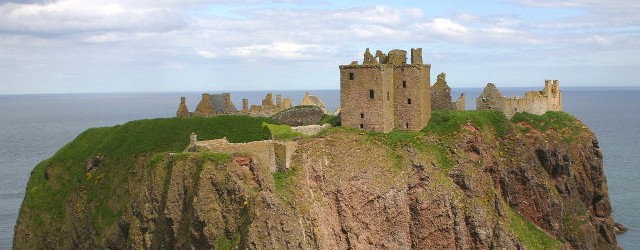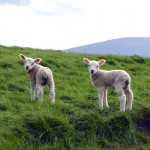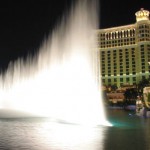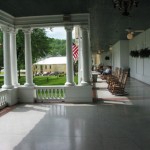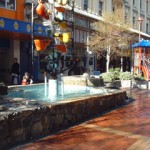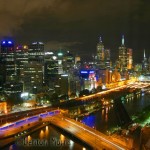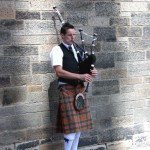 Article by Jae-Ha Kim
Article by Jae-Ha Kim
Photos by Denton Morris
(Chicago Sun-Times)
ABERDEEN, SCOTLAND — Yes, Scots eat haggis and talk with accents as thick as the blood used in their beloved black pudding. Their love of football (that’s soccer to us Yanks) is equaled only by the desire for good conversation. And they welcome strangers into their country with open arms and a big hearty “‘ello!”
Just don’t make the mistake of calling one of them a Brit. They’re Scottish.
Scotland has become almost a caricature of itself in the American media with comics imitating Sean Connery’s brogue and Mike Myers “If it’s not Scottish, it’s crap!” skits on “Saturday Night Live.” Often viewed as less cosmopolitan than England but not pastoral enough to be as pretty as Switzerland, Scotland actually is all that and more. With some fabulous gourmet restaurants, the gorgeous countryside and some of the most amazing castles and ruins — all within a few hours drive — Scotland is a wonderful destination for travelers who want it all without having to learn another language.
I started my trip in Scotland’s laid-back Orkney Islands — which lie just north of the mainland. Remember that thing about calling Scots British? Refer to any of the 19,000 inhabitants of the Orkney Islands as a Scot and he or she will politely but firmly inform you they are not Scots. They’re Orcadians.
They may live just a few miles north of mainland Scotland, but they are an entity unto themselves. Unlike residents of cosmopolitan Edinburgh and nouveau chic Glasgow, Orcadians don’t revel in trendy nightlife or upscale boutiques catering to the rich and bored.
Instead, they welcome curious tourists who somehow found their way to the islands with directions to the nearest pub or the shopping center in its quaint downtown area.
Once the land of Vikings, the Scandinavian influence still is prevalent in the Orkneys. On the island of Shapinsay, a group of seals suns themselves near Burroughston Broch, an ancient Viking stronghold. In nearby Stromness, you can see Scandinavian greetings carved into the walls of the ancient tombs at Maes Howe. Their literal translation isn’t far off from today’s graffiti of “Sven was here.”
Orkney consists of some 70 islands, only 16 of which are inhabited. Most locals live in Kirkwall and Stromness, and they will be the first to admit there isn’t much of a nightlife other than a club called Fusion. But let’s face it. The Orkneys aren’t about nightclubs. They’re the ultimate getaway for harried folks trying to escape the quick-paced stress back home.
Though most of the 250,000 tourists visiting the Orkneys each year hail from Europe, the islands slowly are becoming a popular destination for more Americans.
And while it would be exaggerating to describe Orkney as a romantic getaway, the island does have a fabulous “hotel” that’s perfect for honeymooners — Balfour Castle, built in 1848. I ran into a couple from Cincinnati, who found the “most northerly castle hotel in the world” on the Internet. Though neither knew anyone who had stayed there before, they decided that’s where they wanted to get married. Alison Shepard, 29, and Evan Hildebrandt, 26, liked Balfour so much they extended their honeymoon there by a few extra days.
“We just wanted to do something intimate for the two of us,” Shepard said. “I’d been to Scotland once before and loved it, but Evan had never been here. We just went with our gut and did it and we’re so happy. We couldn’t have had a better ceremony anywhere.”
Even if you’re going solo, the castle is a wonderful place to release your inner princess. The on-staff chef serves up gourmet food, taking advantage of the herbs from the on-site garden and greenhouse. Orkney is so far north that summer days last about 20 hours and only a few hours in winter.
The meals set the standard for the remainder of the trip. I had been to the United Kingdom before and remembered Scottish food as being filling, but not particularly tasty. The thing I noticed this time around was while an unfortunate restaurant choice left me with little to eat besides canned veggies and bland chicken, the good by far outnumbered the bad.
The U.K. in general gets a bad rap when it comes to cuisine. While it’s not as easy to find yummy food in the Orkneys as in some bigger locales, there are some excellent places. The Stromness Hotel is overrated and pricey considering its boiled peas and carrot fare, but the smaller Royal Hotel serves a fine lamb dinner or a hearty beef potpie.
Then there are the sights, particularly the spectacular collection of massive standing stones dotting the fields. While England’s Stonehenge might be more famous — thanks in part to the film “This is Spinal Tap” — the Orkneys also have bragging rights. Its impressive Standing Stones of Stenness, which loom 19 feet high, tower over the newborn lambs that share the fields.
I was there during lambing season and couldn’t drive for more than a few miles without spotting a small white (and occasionally black) creature. Tiny, furry and impossibly cute, they were usually tailed by their fierce-looking moms who glared and bleated at tourists cooing over their young. The locals weren’t fazed and could be spotted helping farmers corral wayward lambs who hopped to taste the grass on the other side of the fence.
It’s not a good idea to get too attached to the little lambies, though, ’cause you’re likely to meet their slightly older siblings at dinner. The Scots love their lamb and serve it often at meals.
As much as I loved the Orkneys, there was more to see. I wanted to return to Edinburgh to try to find the bed and breakfast I had stayed at in the late 1980s. I figured the precocious little boy who used to wake us up every morning might now be old enough to be running the place. But it turned out it had gone out of business. And as luck would have it, just about all the bed and breakfasts were already booked due to a big rugby match that weekend.
Instead, I found myself at the Malmaison Hotel (www.malmaison.com), which overlooks the harbor in the city’s chic Leith district. Note to future guests: Dress up a bit. My jeans and sneakers were appropriate for a B&B but not for an upscale hotel. Not that the staff treated me any worse. They were incredibly helpful and gave suggestions where I should eat.
Which leads to my next suggestion: Be sure you make reservations for restaurants. Virtually every establishment that weekend had a long waiting list unless you had already reserved a table. One night I ate takeout fish and chips in my hotel room (delicious, with just the right amount of vinegar sprinkled over both). Another time, I ended up dining at the Raj, the only restaurant that had any openings. Now I don’t like Indian food — or at least I thought I didn’t. But the cuisine was absolutely delicious. I steered away from the milky curry dishes I knew I disliked and ordered spicy Tandoori chicken. The bright red color was gorgeous and the array of spices (garlic, masala and paprika) was perfectly complemented by the nan (flat bread) and fried rice. The cool yogurt and cucumber dressing added a nice, light touch to the meal.
One thing I learned early on was regardless of whether I was staying at a bed and breakfast or a hotel, it was worth my while to get up early and enjoy the full Scottish breakfast. The menu changed depending on the venue, but it always included hot toast with fresh butter and jams, thick bacon or sausage, grilled tomatoes and possibly fried potatoes, juice and tea (or coffee). At certain places like the Frog Marsh bed and breakfast in the hamlet of Mosset in Aberdeenshire, you also got a serving of haggis. The Scottish delicacy isn’t for everyone. But if you like sheep’s pluck (the stomach bag) and lamb’s liver, I swear you’ll love it.
The Frog Marsh was another Internet find I booked while still in America. I picked it because it was near many of the sites I wanted to visit and owners Louise Barker and Cindy Salvin sent back charming replies to my e-mails. I honestly didn’t expect much from any place with “frog” in its name, but the price was right (between about $55 to $90 per person each night). I’ve stayed at Four Seasons properties and the Bellagio in Las Vegas, but I can honestly say this was one of my favorite places. Maybe it was the gourmet food (about $35 for dinner). Or it could’ve been the Robbie Williams book I pored over in the library while they served me high tea. But the charming (and clean!) rooms with fresh white linens and quilts made you feel as if you were still at home — a much cleaner, better decorated home than you left back in the United States.
When you’re this far off the beaten path, it really does help to have a rental car. Some of you might be squeamish about driving in a foreign country on the other side of the road.
But the Scots are such gracious drivers that navigating even the reverse roundabouts were a breeze. When I stopped to ask for directions, the cabbies and pedestrians alike would take the time to direct me to my destination — and no one honked or gave me the finger. Go figure.
I relied on a combination of rental cars, cabs and the BritRail pass to get around. The BritRail pass was perfect to get me from Glasgow to Edinburgh in about an hour. But for castle hopping, you really need to befriend a local who’ll drive you around or brave it yourself.
Staying overnight at Balfour Castle was a dream come true. But visiting some of Scotland’s most historical castles was something incredible to behold. Edinburgh Castle is on every tourist’s must-see list, as it should be. Walking inside the walls that once protected the royal family, you can’t help but be at least a little awed by the massive structure. Outside, there are shops hawking all things Scotland and vendors selling delicious treats. A small boy and his father re-enact a scene from “Braveheart.” As the little boy holds up a “head,” the man asks, “Who’s head is that?” The child pipes in, “Beckham’s!” (referring to English soccer great David Beckham).
If you have time, try to make a trip to Dunnottar Castle, about 15 miles from Aberdeen. Mel Gibson fans will recognize the ruin, which was the location for his film “Hamlet.” Sitting atop an enormous flat-topped rock, steep cliffs on all but one side of it ensured that enemies would have a difficult time infiltrating.
Two hours north of Edinburgh in Angus lies the Arbroath Abbey, which is the remains of the monastery William the Lion founded in 1178 as his burial place. Two centuries later, the Abbey was the site where Scotland asserted its independence from England by signing the Declaration of Arbroath in 1320.
Since I was already in the city of Aberdeen, I had to check out the rumor that Elvis Presley’s ancestors hailed from a nearby town called Lonmay. Actually, as the residents point out, Lonmay is such a small strip of land it’s more of a hamlet than a city. Author Allan Morrison says he traced Presley’s ancestry back more than 250 years to Lonmay. Tour guides in Aberdeenshire said they heard from somebody who heard it from someone else that there was a plaque dedicated to Presley at the local butcher shop in Lonmay.
But ask the locals and they’ll just grin. They’ll also point out there is no butcher shop in Lonmay.
“I think it’s a good publicity stunt,” one elderly gentleman said. “I had heard that there were two Presley brothers and one may have gone to America, but I never heard that he was the one related to Elvis Presley.”
I didn’t find Elvis during this trip to Scotland, but what I discovered there was so much more important. This city girl has always valued modern architecture and cosmopolitan activities more than the country life. “Nature is so overrated,” is my usual response to friends who want me to go camping or hiking.
And yet, for almost two weeks, I reveled in the beauty Scotland had to offer. Yes, the restaurants were awesome and the high-tech hotels made me feel as if I was in New York. But what I remember most are the majestic castles, the lush pageantry of Aberdeenshire and the tiny little lambs.
While I wouldn’t go so far as to say that if it’s not Scottish, it must be crap, I finally understand what Mike Myers has been insisting all these years.
IF YOU GO
Fly from Glasgow or Edinburgh to the Orkney Islands via Logan Air (www.loganair.co.uk). Decide before you get there whether you want to hire a car and/or travel by BritRail (www.britrail.com). It’s a good idea to make reservations for both while you’re still in the United States. For more information on Scotland, check out www.toscotland.com and www.visitscotland.com.
WHERE TO STAY
In the Orkney Islands, Shapinsay’s Balfour Castle (www.balfourcastle.co.uk) is a must, with rooms starting about $175 per person for bed and breakfast. For more modest accommodations, try the Mill of Eyrland near Stromness (www.bedandbreakfast-directory.co.uk/info.asp?id=846), with single rooms starting about $60 per night for bed and breakfast. There are plenty more bed and breakfast options at www.aboutscotland.com, which is where I found Frog Marsh (www.frogmarsh.com). In Edinburgh, swing by the Malmaison (www.malmaison. com) for at least a drink, if not a pampered night of sleep.
TO TIP OR NOT TO TIP
Let’s face it: The United States is one of the most tip-happy countries in the world. You tip maids, servers and doormen. But when you’re in a foreign country, what do you do?
The locals always will tell you if natives tip or not. I remember the Kiwis rarely tipped in New Zealand and then only if service was extraordinary. The policy also seems to hold true in the United Kingdom. Cheapskates on a budget may revel at not being expected to tip. But the problem is that while locals don’t expect tips from their fellow countrymen — or perhaps even from other Europeans — they’ve come to expect them from Americans, who tend to tip out of habit automatically.
Just keep in mind the exchange rate when you’re tipping (or paying for anything for that matter). The British pound was worth almost $2 when I was there and I had to remember that a 3-pound tip was almost $6. No wonder the cab drivers loved me so much.
© Jae-Ha Kim and Denton Morris
